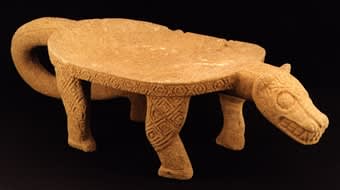Atlantic Watershed Basalt Metate in the Form of a Jaguar, 700 CE - 1000 CE
Basalt
9 x 33.5
PF.2394
Monumental zoomorphic-effigy grinding stones such as this magnificent stone jaguar metate were the most important ritual objects of their time in Costa Rica. Exquisitely carved from a single piece of...
Monumental zoomorphic-effigy grinding stones such as this magnificent stone jaguar metate were the most important ritual objects of their time in Costa Rica. Exquisitely carved from a single piece of volcanic rock with only stone and wood tools plus abrasives, these metates exhibit remarkably graceful lines and proportion. Like an mankind, the Ancient Costa Ricans sought to relieve the uncertainties of death. This quest for immortality and a reverence for ancestors led to elaborate burial practices. This powerful metate functioned as a special burial item, its presence in the tomb insuring the deceased of an eventual rebirth, the beginning of a new life. The metate symbolized this transformation because of its every-day utilitarian function as a grinding stone, transforming a seed or kernel into flour. The ancient beauty, strength and dynamism that this jaguar effigy exuded in the past can still be seen and experienced today. Its powerfully carved head with snarling teeth and flared nostrils, the curled tail caught in suspended motion, the slightly bent legs with their energetically carved geometric patterns, all combine to give this feline a timeless artistic dynamism. In fact, the creativity evidenced in this piece and other ceremonial metates of its time contributed to the creation of the first freestanding sculpture in the region. The legacy of this jaguar most surely continues into the present for its power and beauty is still a joy to behold.
